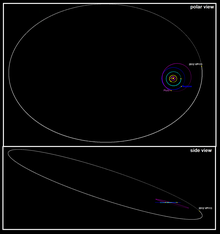2012 VP113
 2012 VP113与冥王星的轨道 | |
| 发现[1] | |
|---|---|
| 发现者 | 斯科特·谢泼德 乍德·特鲁希略 托洛洛山美洲际天文台 |
| 发现日期 | 2012年11月5日 2014年3月26日宣布 |
| 编号 | |
| MPC编号 | 2012 VP113 |
| 小行星分类 | 海王星外天体 |
| 轨道参数[2] | |
| 历元 2013 Oct 30.0 2456595.5 JD | |
| 远日点 | 461 ± 31 AU (Q) |
| 近日点 | 80.3 ± 0.8 AU (q) |
| 半长轴 | 271 ± 13 AU (a) |
| 离心率 | 0.703 ± 0.016 |
| 轨道周期 | 4452.5 ±(?) yr |
| 平近点角 | 2.89±0.09 |
| 轨道倾角 | 24.013°±0.013° |
| 升交点黄经 | 90.896°±0.017° |
| 近日点参数 | 293.1°±2.7° |
| 物理特征 | |
| 大小 | 300–1000公里[3] 450公里(假设)[3] 636公里[4] 586公里[5] |
| 反照率 | 0.1(假设)[5] |
| 绝对星等(H) | 4.1[6][7] 4.0[2] |
2012 VP113是一颗海王星外天体[8]。天文学家于2014年3月26日宣布发现2012 VP113[9][10]。2012 VP113的绝对星等(H)为4.1等[6],所以它可能是一颗矮行星[5]。它的大小预计为塞德娜的一半,大约与雨神星相当[3]。发现2012 VP113团队昵称这颗天体为“副总统”(VP)或“拜登”,因为发现当时的美国副总统为乔·拜登[10]。
2012 VP113表面被认为是具有粉红色的色调,来自于辐射对于冷冻水、甲烷和二氧化碳产生化学作用变化[11]。这种颜色来自于巨大气体区域,而不是传统的柯伊柏带(多数为暗红色天体)[9]。
发现过程[编辑]
2012年11月5日,2012 VP113首次被天文学家发现,当时天文学家使用美国国家光学天文台托洛洛山美洲际天文台4米口径的维克托·M·布兰科望远镜(Víctor M. Blanco Telescope)观测天空。天文学家之后利用智利拉斯坎帕纳斯天文台卡内基科学机构6.5米口径的麦哲伦望远镜被确定其轨道及表面特性。天文学家公布2012 VP113发现消息前,只通过托洛洛山美洲际天文台(807)和拉斯坎帕纳斯天文台(304)追踪过该天体[7]。2012 VP113的观测弧约1年[6]。
轨道[编辑]
2012 VP113拥有在所有太阳系已知天体中最远的近日点。2012 VP113在1979年左右通过近日点,距离太阳为80天文单位,它目前距离太阳为83天文单位。其余只有四个太阳系天体已知有超过47天文单位以上的近日点:小行星90377(76 AU)、2004 XR190(51 AU)、2010 GB174(48 AU)与2004 VN112(47 AU)[12]。近日点位于50-75天文单位的天体似乎不容易被天文学家观测到[9]。
2012 VP113可能是一颗假设的内奥尔特云成员[13][14][3]。它的近日点、近心点幅角与位置类似塞德娜[3]。事实上,所有已知半长轴超过150天文单位、近日点位于海王星以外的天体,近心点幅角都聚集于340°附近。这种现象可能表示这些天体的形成机制类似[9]。
2012 VP113的近日点距离为何位于柯伊伯带以外目前仍然未知。它的轨道特点(类似塞德娜)都被解释为可能是由一颗恒星或一颗几百地球质量的类海王星行星于距离太阳数百个天文单位的位置经过所造成的[15]。2012 VP113甚至可能是被捕获的太阳系外行星[16]。然而,天文学家认为2012 VP113更有可能的是多个疏散星团(太阳在其中形成)交互作用所造成的[3]。
参见[编辑]
参考资料[编辑]
- ^ MPEC 2014-F40 : 2012 VP113. IAU Minor Planet Center. 2014-03-26 [2014-02-20]. (原始内容存档于2017-08-16). (K12VB3P)
- ^ 2.0 2.1 2012 VP113 has Q=460 +/- 30 (页面存档备份,存于互联网档案馆) (mpml: CFHT 2011 precovery)
- ^ 3.0 3.1 3.2 3.3 3.4 3.5 Lakdawalla, Emily. A second Sedna! What does it mean?. Planetary Society blogs. The Planetary Society. 2014-03-26 [2014-03-27]. (原始内容存档于2019-09-08). 外部链接存在于
|work=(帮助) - ^ Conversion of Absolute Magnitude to Diameter for Minor Planets (页面存档备份,存于互联网档案馆) using H = 4.1 and the theoretically expected albedo of 0.1
- ^ 5.0 5.1 5.2 Michael E. Brown. How many dwarf planets are there in the outer solar system? (updates daily). California Institute of Technology. [2014-03-28]. (原始内容存档于2011-10-18).
- ^ 6.0 6.1 6.2 JPL Small-Body Database Browser: (2012 VP113) (last observation: 2013-10-30 (arc=~1 year)). Jet Propulsion Laboratory. [2014-03-26]. (原始内容存档于2020-04-20).
- ^ 7.0 7.1 2012 VP113 Orbit. IAU Minor Planet Center. [2014-03-26]. (原始内容存档于2016-03-04).
- ^ Chang, Kenneth. A New Planetoid Reported in Far Reaches of Solar System. New York Times. 26 March 2014 [26 March 2014]. (原始内容存档于2020-12-22).
- ^ 9.0 9.1 9.2 9.3 Trujillo, Chadwick A.; Sheppard, Scott S. A Sedna-like body with a perihelion of 80 astronomical units. Nature. 2014-03, 507 (7493): 471–474 [2018-02-24]. ISSN 1476-4687. doi:10.1038/nature13156. (原始内容存档于2021-01-19).
- ^ 10.0 10.1 Witze, Alexandra. Dwarf planet stretches Solar System's edge. Nature. [2018-02-24]. doi:10.1038/nature.2014.14921. (原始内容存档于2019-08-22).
- ^ Sample, Ian. Dwarf planet discovery hints at a hidden Super Earth in solar system. The Guardian. 26 March 2014 [27 March 2014]. (原始内容存档于2021-01-13).
- ^ JPL Small-Body Database Search Engine: q > 47 (AU). JPL Solar System Dynamics. [2014-03-26]. (原始内容存档于2017-04-20).
- ^ Wall, Mike. New Dwarf Planet Found at Solar System's Edge, Hints at Possible Faraway 'Planet X'. Space.com web site. TechMediaNetwork. 2014-03-26 [2014-03-27]. (原始内容存档于2014-03-28).
- ^ NASA Supported Research Helps Redefine Solar System's Edge. NASA. 26 March 2014 [26 March 2014]. (原始内容存档于2020-11-12).
- ^ A new object at the edge of our Solar System discovered. Physorg.com. 26 March 2014 [2014-03-29]. (原始内容存档于2016-06-20).
- ^ Scott S. Sheppard. Beyond the Edge of the Solar System: The Inner Oort Cloud Population. Department of Terrestrial Magnetism, Carnegie Institution for Science. [2014-03-27]. (原始内容存档于2014-03-30).
外部链接[编辑]
- Orbital simulation(页面存档备份,存于互联网档案馆) from JPL (Java) / Horizons Ephemeris(页面存档备份,存于互联网档案馆)
- 2012 VP113 Inner Oort Cloud Object Discovery Images from Scott S. Sheppard/Carnegie Institution for Science.
| ||||||||||||||||||||||||||||||||||||||||||||||||||||||
| ||||||||||||||||||||||||||||||||||||||||||
